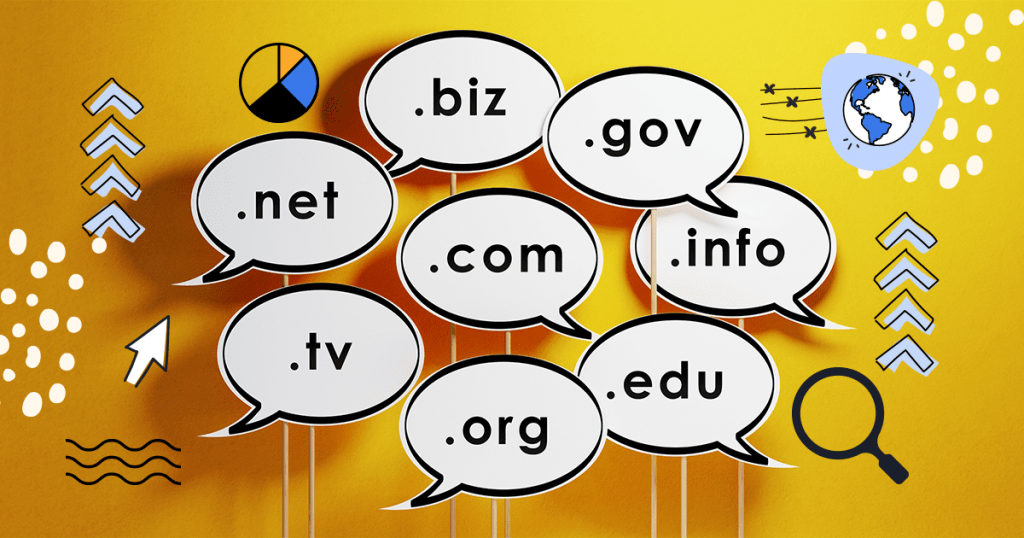A website address contains several different elements that help set it aside and be remembered. Among those is the top-level domain (TLD), which includes the letters after the period such as .com and .net.
Have you ever wondered what they are and what’s their importance?
Aside from being a part of a website URL, the top-level domain is the highest level in the internet’s hierarchical Domain Name System (DNS).
As such, it is highly important not only for a website to function but also to appear legitimate to potential visitors.
Deciding on what TLD to use is part of the process of setting up a website. There are multiple official organizations that manage domain names.
In addition, some hosting services bundle them with the rest of their solutions. Picking the right one can make a whole difference in your results.
Would you like to learn more about top-level domains and why they are so important? Here is everything you will see in this article:
- What is Top-level Domain?
- What are the Different Types of Top-level Domain?
- What is the Purpose of Having Different Top-level Domains?
- Who is Responsible for Managing TLDs?
- Can You Get Any Top-Level Domain You Want?
- Can You Change Your WordPress Site’s TLD?
- How Does the Top-level Domain Affect SEO?
- Wrap Up
Download this post by entering your email below
What is Top-level Domain?
A top-level domain is a group of letters that appear as part of a website address URL.
For instance, in www.example.com, .com is the TLD.
That is the most common one but there are others that are either restricted to certain kinds of businesses or are just as open.
When creating your own website, you must first register a domain name. This process includes the selection of a top-level domain that fits your business category.
However, such a choice should not be rushed as it has an impact on your address appearance and how easy or hard it is to remember it.
Certain TLDs have specific origins and purposes, depending on their kind. For instance, .com is mostly used for commercial organizations while .gov is reserved for governmental bodies.
Depending on your company’s field, it might not be possible to choose just any TLD.
TLDs are reserved by the nonprofit organization Internet Corporation for Assigned Names and Numbers (ICANN). Any company that sells and maintains top-level domains must deal directly with ICANN.
What are the Different Types of Top-level Domain?
Checking a top-level domain list is a great way to help you decide which one to use on your website.
However, before that, you should know there are multiple different types of TLDs that might put some restrictions on your choosing process. After all, some of them are reserved for specific situations.
Below, you will find the most important types of top-level domains and some examples.
1. Generic top-level domains (gTLD)
The most common type of top-level domain is the generic kind, or gTLD. It consists of codes such as .com, .info, .net, and .org, which are all widely used on the web.
These were the domain codes originally created in the system’s early development alongside country-code domains, which is why they are named generic.
2. Sponsored top-level domains (sTLD)
A sponsored top-level domain (or sTLD) requires a sponsor that represents the community that is served by the domain. They include governments, education institutions, associations, museums, federal services, and others.
Among the examples of sTLD are .gov, .edu, .mil, .int, and .coop. Sponsored top-level domains also include a domain that is restricted to pornographic sites (.xxx).
3. Country-code top-level domains (ccTLD)
There are also country-code top-level domains, ccTLD in short. These are usually reserved for countries, sovereign states, or any other type of territory with a country identification.
All the codes are two-letter long and represent abbreviations of the respective countries.
For example, the code for the United States is .us, while the United Kingdom uses .uk in domains.
4. Infrastructural top-level domains
Today, infrastructural top-level domains are exclusively used within the internet’s infrastructure system (as with functions like reverse DNS lookup). In most cases, they end in .arpa.
They were initially set up as temporary domains during the integration of .arpa domains into the larger system.
However, it was eventually decided that it was more practical to simply transition their use to infrastructural purposes instead of retiring them altogether.
5. Reserved top-level domains
Reserved top-level domains are pretty much exactly what they sound like — domains that have been excluded from the general registration system for any number of reasons.
They include (but may not be limited to):
- To prevent potential name collision (as with domain names of only a couple of characters)
- As a means to register specific high-value domain names by application only (as with certain keyword-based .me domains)
6. Test top-level domains
As with the .arpa domain names used for internet infrastructural reasons, .test domains are not part of the general domain name system.
They are exclusively used by the Internet Engineering Task Force to test software.
The fact that they are unavailable for general registration makes it easier to run these tests without any risk of conflict with other existing or potential domain names.

What is the Purpose of Having Different Top-level Domains?
Despite web addresses being closely associated with a site’s identity — and being the way we access them —, they are actually user-friendlier “masks” that represent IP addresses.
For example, when you type in www.google.com, that is in fact a shortcut to its real location, which is 172.217.173.68.
Since it is easier to remember simpler URLs, the web standardized the process of using the Domain Name System (DNS) to sort them into names and words. Part of that structure includes the top-level domain, which further categorizes them.
However, ICANN selected a number of codes to further identify specific URLs. We now have over 1,500 TLDs available, which can fit multiple fields of businesses, organizations, and communities.
Additionally, the same website can use several TLDs to reach a further audience, if so wished.
Who is Responsible for Managing TLDs?
The Internet Assigned Numbers Authority (IANA) is the entity responsible for managing the top-level domain system.
Its duties include general organization and maintenance of the system, as well as the delegation of the various domain options.
The IANA is presently part of the Internet Corporation for Assigned Names and Numbers (ICANN), a non-profit established in 1998 specifically to serve this purpose.
Can You Get Any Top-Level Domain You Want?
Although today’s internet users and web developers have a lot of freedom regarding their top-level domain choices, you can’t actually choose any TLD you want.
Remember, some domains are reserved for specific purposes like internal software testing or application-only registration.
However, beyond that, your options are really pretty wide open, especially when it comes to publicly available generic domain name types, like .com, .net, or .info.
Choose your TLD carefully, as your choice will affect the perception your future visitors have of you and your company.
Can You Change Your WordPress Site’s TLD?
A domain name that worked well for someone’s purposes when they first built their website may or may not still be appropriate years later.
For example, people rebrand their businesses, change their companies’ names, and occasionally simply change their minds.
That said, yes, you can change your website’s top-level domain if you’re running WordPress. It’s also reasonably painless.
Here’s a brief rundown of the steps involved.
- Change both your WordPress address and site address via your WordPress dashboard under general settings.
- Edit the wp-config.php file in your WordPress installation to reflect your new domain name.
- Update your wp_options in your hosting control panel to reflect the changes. (Make sure you update both the “siteURL” and “home” sections.)
It’s also a good idea to set up a URL redirect from your old domain to your new one.
You want visitors to find their way to the right place, whether they’re aware of your domain name change or not.
How Does the Top-level Domain Affect SEO?
A top-level domain is a very important part of your website’s identity and, as such, it also has an impact on SEO techniques.
Everyone needs to keep a close watch on how search engines prioritize results as these criteria can change depending on new discoveries and habits.
Here is everything you need to consider when choosing a top-level domain in terms of SEO.
Associations with illegitimate businesses
Google and other search engines always look into offering the best and safest results to people who make searches but public perception can affect that.
Historically, certain TLDs have been associated with illegitimate businesses and spam, and as such, using them might damage your SEO. Here are some examples: .zip, .review, .country, .biz, and .info.
Industry-specific TLD boost
It might be beneficial to your SEO to use top-level domains that are associated with your industry. For instance, those in the tech sector might get an SEO boost by using .tech or .io, as several startups already do.
Geotargeting through ccTLD
By choosing a country-code top-level domain that fits the location of your base of operations, you might get an SEO boost through geotargeting.
This means your results can appear to more people making searches in your country. This also applies to international pages for multinational businesses.
Risk of performance hits
In case you pick a country-code top-level domain, be mindful to use a hosting service with localized servers. Offering a bad experience to international visitors might damage your optimization and make you lose positions within Google’s rankings.
A domain is an integral part of a website’s structure. When creating your own, you must also decide on how your address is going to look like since it has a direct impact on your visitor’s ability to browse your pages.
Wrap Up
Now that you understand the significance of top-level domains, it’s time to elevate your website to new heights.
Choosing the right top-level domain is just one step in building a successful online presence. If you’re ready to take your website’s performance, conversion, and security to the next level, consider the Stage.
Stage, our comprehensive solution for WordPress, ensures you can focus on what matters most—your content and strategy—without the hassle of technical complexities.
Take the next step with Stage and experience seamless hosting, powerful conversion plugins, personalized services, and effortless blog creation—all tailored to enhance your Inbound Marketing strategy.
Ready to transform your online presence? Explore Stage now.









